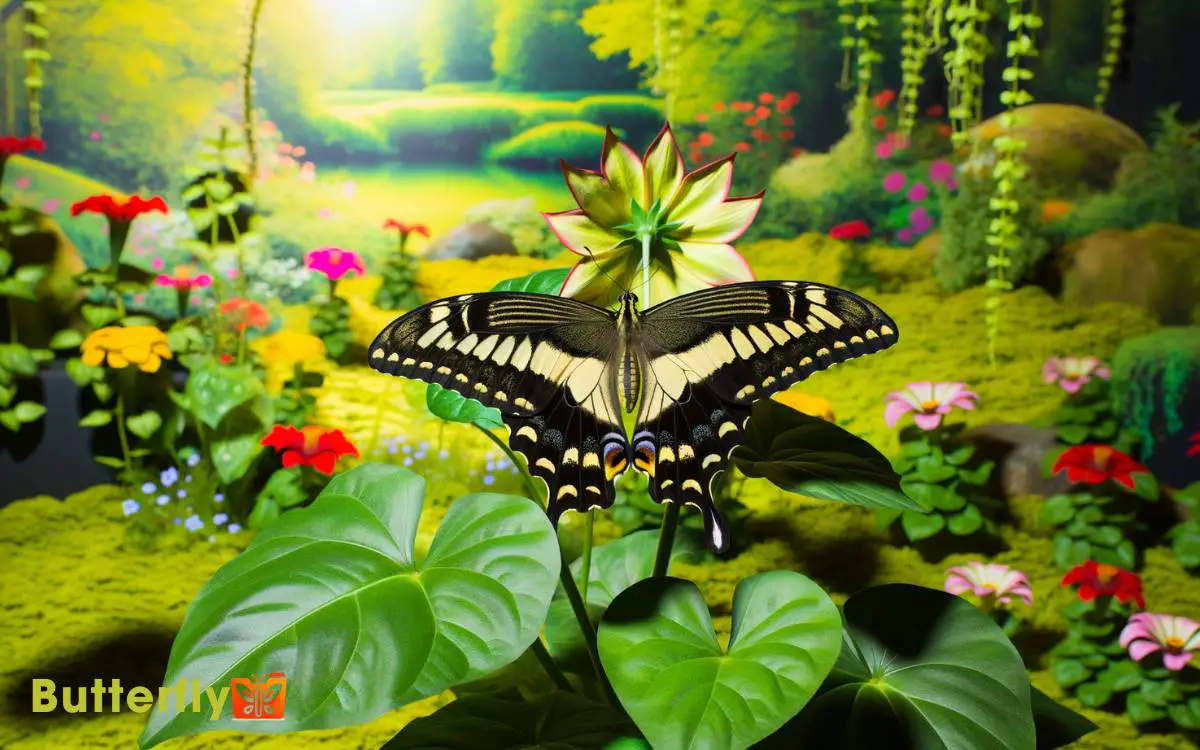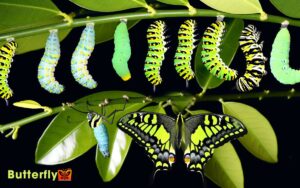Giant Swallowtail Butterfly Fun Facts: Discover More!
The Giant Swallowtail Butterfly stands out with a wingspan reaching up to 6 inches and vibrant yellow and black patterns, which help in thermoregulation and predator avoidance.
Its larvae resemble bird droppings to camouflage from predators. They feed on nectar from plants like lantana and occasionally on rotting fruit.
Found from the southern US to South America, these butterflies use the sun’s position for accurate navigation during migration. Despite their bright coloring, which signals toxicity to predators, they also emit a foul odor when threatened.
For those keen on its intricate life cycle and survival mechanisms, there’s much more to discover.

Key Takeaways
Impressive Wingspan
The Giant Swallowtail butterfly boasts an impressive wingspan that can reach up to 6 inches, making it one of the largest butterflies in North America.
This expansive wingspan enables the butterfly to glide effortlessly through the air, covering large distances with minimal energy expenditure. The wings are structured with strong, yet lightweight veins that provide both flexibility and durability.
These features allow the butterfly to maneuver adeptly, evading predators and traversing varied terrains. The Giant Swallowtail’s flight patterns are characterized by slow, graceful flaps interspersed with rapid bursts.
This unique combination of agility and endurance makes it a master of both short sprints and long-distance travel, embodying the essence of freedom in the natural world.
Striking Coloration
Beyond its impressive wingspan, the Giant Swallowtail butterfly captivates with its striking coloration, featuring a combination of vibrant yellow and deep black patterns that serve both aesthetic and practical purposes.
This intricate design isn’t just for show; it provides several survival advantages:
- Camouflage: The yellow and black coloration mimics sunlight filtering through foliage, helping the butterfly blend into its environment.
- Warning: Bright colors can signal potential toxicity to predators, deterring attacks.
- Thermoregulation: Darker hues absorb sunlight, aiding in temperature regulation.
- Mating: These vivid patterns play an important role in attracting mates during the breeding season.
Each element of the Giant Swallowtail’s coloration is a demonstration of its evolutionary ingenuity, ensuring its survival and reproduction.
Unique Life Cycle
From egg to adult, the Giant Swallowtail butterfly undergoes a fascinating and complex metamorphosis that highlights distinct stages of development.
Females lay spherical, pale yellow eggs on host plants. After a few days, larvae emerge, resembling bird droppings as a form of camouflage.
These caterpillars molt several times, each stage called an instar, growing larger and changing slightly in appearance.
Eventually, the caterpillar forms a chrysalis, suspending itself with silk. Inside, it undergoes pupation, where its body structure transforms dramatically.
After about two weeks, the adult butterfly emerges, ready to spread its wings and begin the cycle anew. Each stage is vital, ensuring the survival and propagation of this remarkable species.
Habitat and Range
After emerging as adults, Giant Swallowtail butterflies mainly inhabit deciduous forests, citrus groves, and suburban gardens across North America, extending from the southern United States down to Central and South America.
These butterflies prefer warm climates and are often found in areas that provide ample sunlight and diverse plant life.
Their range includes:
- Southern United States: States like Texas, Florida, and Louisiana.
- Central America: Countries such as Mexico and Honduras.
- South America: Regions including Colombia and Venezuela.
- Caribbean Islands: Islands like Cuba and Puerto Rico.
These habitats offer the necessary resources for their survival and reproduction, including host plants for their larvae. They thrive in environments that balance urban development with natural vegetation.
Feeding Habits
Feeding primarily on nectar, Giant Swallowtail butterflies exhibit a preference for flowers that produce abundant and accessible nectar.
They’re particularly attracted to lantana, azalea, and bougainvillea. These flowers’ tubular structures facilitate efficient nectar extraction.
In addition to nectar, adults occasionally feed on rotting fruit and tree sap, sources rich in carbohydrates and minerals. Caterpillars of the Giant Swallowtail feed on the leaves of citrus plants, including lemon, lime, and orange trees.
They employ a specialized feeding method, chewing through leaves to maximize nutrient intake. This dietary specificity supports their rapid growth and development.
Predators and Defense
Giant Swallowtail butterflies, while sustaining themselves on a diverse diet, must also navigate a landscape teeming with predators and have evolved intricate defense mechanisms to enhance their survival. Predators include birds, lizards, and spiders.
To counter these threats, they employ several strategies:
- Camouflage: Their caterpillars mimic bird droppings, blending seamlessly with their surroundings.
- Chemical defense: They produce toxic substances that deter predators.
- Aposematism: Bright colors on their wings signal toxicity, warning potential enemies.
- Mimicry: Adult butterflies mimic the appearance of toxic species to avoid predation.
These defense tactics are essential for their survival, allowing them to thrive despite the constant threat of predation.
Understanding these mechanisms reveals the complexity and beauty of butterfly evolution.
Mating and Reproduction
The Giant Swallowtail Butterfly exhibits intricate courtship behavior, involving aerial displays and pheromone release by the male.
After successful mating, the female meticulously selects host plants, often citrus, to lay her eggs.
Each egg is carefully deposited on the underside of leaves, optimizing protection and access to food for the emerging larvae.
Courtship Behavior
Male Giant Swallowtail butterflies initiate courtship by performing intricate flight patterns to attract females. These aerial displays showcase their agility and stamina, critical traits for successful mating.
During courtship, males engage in several precise behaviors:
- Spiraling Flights: Males fly in tight spirals around potential mates to capture their attention.
- Hovering: They hover near females, exhibiting their vibrant wing patterns.
- Pheromone Release: Males release pheromones to signal their readiness to mate.
- Pursuit Flights: Persistent males chase and follow females to encourage mating.
These behaviors guarantee that only the fittest males reproduce, promoting genetic diversity.
The meticulous nature of these courtship rituals underscores the butterfly’s complex reproductive strategies, essential for sustaining the population and adapting to environmental changes.
Egg Laying Process
Female Giant Swallowtail butterflies meticulously select host plants for oviposition, guaranteeing their larvae have ideal food sources upon hatching.
They primarily choose citrus plants, carefully depositing their eggs on the tender young leaves. Each egg is singularly placed, maximizing survival rates and ensuring sufficient nutrition.
Once the eggs hatch, larvae go through several instar stages, each characterized by distinct morphological changes. This precise process guarantees that the larvae have the best chance of reaching maturity.
Here’s a quick breakdown of the egg-laying process:
| Stage | Description | Duration |
|---|---|---|
| Oviposition | Egg laying on host plants | 1-2 days |
| Egg Hatching | Emergence of larvae | 6-10 days |
| Larval Stages | Multiple growth stages (instars) | 3-4 weeks |
This methodical approach ensures the next generation of Giant Swallowtails thrives.
Role in Ecosystem
Playing an essential role in pollination, the Giant Swallowtail butterfly helps maintain the biodiversity of various ecosystems. This butterfly facilitates the transfer of pollen, enabling plants to reproduce and sustain their populations.
Additionally, it serves as a food source for various predators, contributing to the food web’s balance. The Giant Swallowtail’s presence indicates a healthy environment, as they thrive in undisturbed habitats.
Key contributions of the Giant Swallowtail butterfly include:
- Pollination: Enhances genetic diversity among flowering plants.
- Food Source: Provides nutrition for birds, spiders, and other insects.
- Bioindicator: Reflects ecosystem health and stability.
- Habitat Maintenance: Aids in the reproduction of host plants, ensuring their survival.
Their role is critical for ecological harmony and resilience.
Seasonal Behavior
The Giant Swallowtail butterfly exhibits distinct seasonal behaviors. Particularly in its migration patterns and breeding season activities. Researchers have noted that these butterflies migrate to warmer regions during colder months, ensuring ideal survival conditions.
Additionally, their breeding season typically occurs in the spring and summer. When environmental factors are most conducive for larval development.
Migration Patterns Observed
During late summer and early fall, Giant Swallowtail butterflies set out on a southward migration to escape the impending cold of northern climates. Their migration patterns are precise and driven by environmental cues.
The journey is characterized by several key behaviors:
- Navigational Accuracy: They utilize the sun’s position to maintain a consistent direction.
- Energy Conservation: Butterflies stop periodically to feed on nectar, replenishing their energy reserves.
- Altitude Adaptation: They adjust flight altitude based on weather conditions, avoiding strong winds.
- Habitat Selection: They seek out suitable habitats with ample food sources and minimal predators.
These behaviors safeguard their survival and successful relocation to warmer regions, showcasing their intricate adaptation mechanisms.
Breeding Season Activities
As the Giant Swallowtail butterflies reach their warmer destinations, they participate in complex breeding season activities that secure the continuation of their species. Male butterflies patrol territories, engaging in aerial displays to attract females.
Females select best-suited host plants for oviposition, guaranteeing larvae have sufficient food. Mating rituals involve intricate flight patterns and pheromone exchanges, essential for reproductive success.
Eggs are laid on the leaves of citrus plants, where larvae will later emerge.
| Activity | Description | Purpose |
|---|---|---|
| Patrolling | Males fly to secure territory | Attract females |
| Oviposition | Females lay eggs on host plants | Ensure larvae nourishment |
| Mating Rituals | Flight patterns and pheromone release | Facilitate mating |
| Egg Laying | Eggs deposited on citrus leaves | Beginning of life cycle |
These activities highlight their intricate reproductive strategies.
Conservation Status
Giant Swallowtail butterflies currently maintain a conservation status of ‘Least Concern’ according to the International Union for Conservation of Nature (IUCN). This status reflects their relatively stable population and widespread distribution.
However, it’s crucial to understand the factors contributing to their continued survival:
- Habitat Flexibility: They thrive in various environments, from forests to urban gardens.
- Wide Geographic Range: Found across North, Central, and South America.
- Host Plant Variety: Utilizes multiple species of the Rutaceae family for larval food.
- Adaptability: Capable of adjusting to environmental changes and human activities.
These factors collectively safeguard the Giant Swallowtail’s resilience, allowing it to maintain a healthy population despite potential threats.
Interesting Adaptations
The Giant Swallowtail butterfly exhibits remarkable adaptations such as camouflage and mimicry, aiding in predator avoidance. As a caterpillar, it resembles bird droppings, providing excellent camouflage against predators. As an adult, its striking coloration and wing patterns can startle or confuse potential threats. Unlike the Giant Swallowtail, the Blue Mountain Swallowtail displays iridescent blue wings, making it a fascinating species to explore when learning about blue mountain swallowtail facts.
Its larval stage mimics bird droppings, providing effective concealment, while the adult’s wing patterns blend seamlessly into the environment.
Additionally, its feeding and growth stages are finely tuned to maximize nutrient intake and guarantee successful metamorphosis.
Camouflage and Mimicry
Displaying a remarkable adaptation, the Giant Swallowtail butterfly employs both camouflage and mimicry to evade predators effectively.
This strategy enhances their survival in the wild through several precise mechanisms:
- Caterpillar Stage: The larvae resemble bird droppings, making them less appealing to potential predators.
- Coloration: Adult butterflies have dark, mottled underwings that blend seamlessly with the forest floor or tree bark.
- Wing Patterns: The bright yellow and black coloration on the upper wings mimics the appearance of toxic species, deterring predators.
- Behavior: They exhibit erratic flight patterns, making it difficult for predators to predict their movements.
This combination of visual deception and behavioral tactics showcases the Giant Swallowtail’s evolutionary ingenuity, embodying nature’s relentless pursuit of freedom and survival.
Feeding and Growth Stages
Shifting focus from their impressive defensive strategies, one can observe how the Giant Swallowtail’s feeding and growth stages exhibit equally fascinating adaptations.
The larvae primarily feed on the leaves of citrus plants, utilizing a unique osmeterium to ward off predators. This organ emits a foul odor when threatened, enhancing their survival.
As they metamorphose, they change into adults that feed on nectar, favoring lantana and milkweed.
| Stage | Feeding Habits | Key Adaptation |
|---|---|---|
| Egg | None | Protective camouflage |
| Larva (1st-3rd) | Citrus leaves | Osmeterium for defense |
| Larva (4th-5th) | Citrus leaves | Mimicry of bird droppings |
| Pupa | None | Camouflaged chrysalis |
| Adult | Nectar from flowers | Long proboscis for nectar feeding |
These stages showcase a series of specialized adaptations, ensuring their growth and survival.
Conclusion
Just when you think you’ve learned all there is about the giant swallowtail butterfly, there’s one more astonishing detail to discover.
Imagine, if you will, the moment when this incredible creature, with its impressive wingspan and striking coloration, takes flight in your own backyard. You’ll see it flitting gracefully from flower to flower, playing its essential role in the ecosystem.
But what secret adaptation allows it to thrive, even in challenging environments? That’s a mystery waiting for you to unravel.






